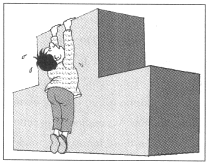2.Sometimes,the simplest ideas are the best.For example,to absorb heat from the sun to heat water,you need large,flat,black surfaces.One way to do that is to build those surfaces specially,on the roofs of buildings.But why go to all that trouble when cities are full of black surfaces already,in the form of asphalt (柏油) roads?
Ten years ago,this thought came into the mind of Arian de Bondt,a Dutch engineer.He finally persuaded his boss to follow it up.The result is that their building is now heated in winter and cooled in summer by a system that relies on the surface of the road outside.
The heat-collector is a system of connected water pipes.Most of them run from one side of the street to the other,just under the asphalt road.Some,however,dive deep into the ground.
When the street surface gets hot in summer,water pumped through the pipes picks up this heat and takes it underground through one of the diving pipes.At a depth of 100metres lies a natural aquifer (蓄水层) into which several heat exchangers (交换器) have been built.The hot water from the street runs through these exchangers,warming the ground-water,before returning to the surface through another pipe.The aquifer is thus used as a heat store.
In winter,the working system is changed slightly.Water is pumped through the heat exchangers to pick up the heat stored during summer.This water goes into the building and is used to warm the place up.After performing that task,it is pumped under the asphalt and its remaining heat keeps the road free of snow and ice.
64.Which of the following is true according to the first two paragraphs?D
A.Arian de Bondt got his idea from his boss.
B.Large,flat,black surfaces need to be built in cities.
C.The Dutch engineer's system has been widely used.
D.Heat can also be collected from asphalt roads.
65.For what purpose are the diving pipes used?D
A.To absorb heat from the sun.
B.To store heat for future use.
C.To turn solar energy into heat energy.
D.To carry heat down below the surface.
66.From the last paragraph we can learn thatB
A.some pipes have to be re-arranged in winter
B.the system can do more than warming up the building
C.the exchangers will pick up heat from the street surface
D.less heat may be collected in winter than in summer.
分析 最简单方法往往很有效.城市里既然有了巨大的"深色"表面,为什么不用来收集太阳能呢?荷兰工程师 Arian de Bondt 就发明了这样一个系统,用于在城市道路上收集太阳热量,以便储存加热地底的水,还可以在冬季使用.
解答 64.D 65.D 66.B
64.D 细节理解题.根据第一段的"to absorb heat from the sun to heat water,you need large,flat,black surfaces.One way to do that is to build those surfaces specially,on the roofs of buildings.But why go to all that trouble when cities are full of black surfaces already,in the form of asphalt (柏油) roads?"可知柏油路也可以用来收集热量.故选D.
65.D 细节理解题.由"The hot water from the street runs through these exchangers,warming the ground-water,before returning to the surface through another pipe."可知潜水管的作用是把热量传导到下面的储水层里.故选D.
66.B 细节理解题.由"After performing that task,it is pumped under the asphalt and its remaining heat keeps the road free of snow and ice."可知这个系统不仅仅是可以给建筑物供暖,还可以防止道路结冰积雪.故选B.
点评 阅读理解题测试考生在阅读基础上的逻辑推理能力,要求考生根据文章所述事件的逻辑关系,对未说明的趋势或结局作出合理的推断;或根据作者所阐述的观点理论,对文章未涉及的现象、事例给以解释.考生首先要仔细阅读短文,完整了解信息,准确把握作者观点



 期末宝典单元检测分类复习卷系列答案
期末宝典单元检测分类复习卷系列答案